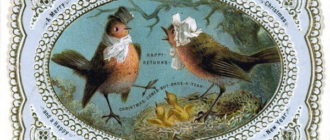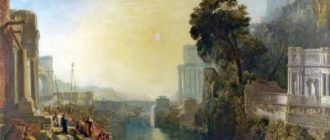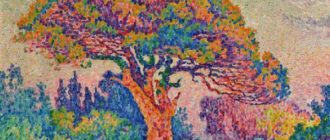
Impression Sunrise is a famous painting by Claude Monet (Oscar-Claude Monet) in 1872. The canvas depicts the port of Le Havre at a time when the landscape is rapidly changing and nature is awakening. The sun rises from the morning mist towards the viewer. It burst into a bright orange ball into the dusk of the night, painted the sky and water a warm pinkish color, and threw an oscillating orange-red carpet on the surface of the bay.
The boats on the water stand out in dark green spots, everything is shrouded in wet fog the ghosts of port cranes, the blurred outlines of the coast, sea vessels. Another moment and pale shadows will slip away, objects will acquire their usual distinctness. And the work itself will give a name to a new direction in painting and become its symbol. But so far the artist has not yet realized this. It seems that he just captured the momentary sensations, filled with the rustle of waves at the pier, the smells of the awakening port and mother-of-pearl reflections on the water.
The painting Impression Sunrise by Claude Monet a landmark work that opened the world to impressionism
Author: Claude Monet (1840-1926).
Year of writing: 1872
Dimensions: 48 x 63 cm.
Style: Impressionism.
Genre: Landscape.
Technique: Oil painting.
Material: Canvas.
Location: Marmottan-Monet Museum, Paris.
Claude Oscar Monet is an outstanding French painter of the 19th century, the founder of Impressionism and the most consistent representative of this trend. He loved to paint water, spent time in the open air, his works, living and moving, convey the “instantaneousness” of the surrounding world, the atmosphere and the light poured into it.
Painting history
The picture Impression. Sunrise with the original unpretentious title” Sea Monet wrote during a short stay in his native Le Havre. That morning he jumped out of bed, ran to the window of the Admiralty hotel, taking his easel and brushes.
Immediately he began to cover the canvas with wide sweeping strokes. After all, at sunrise, the lighting changes every moment. Here you can’t hesitate, you need to quickly prescribe each shade. The artist frantically rushed to capture the view. He simultaneously worked on the entire space of the painting.
The first layer should cover as much of the canvas as possible. Subtle transitions, lightweight base. Sky, docks, water and countless shades of gray. The color is highlighted, there is no black in it. Small blue and purple strokes. Faster and more abrupt movements masts on boats, the outlines of the dock, lost in the haze. And finally, in fiery tones, the sun itself is an orange ball, which has a slightly irregular shape.
The whole work took no more than 10 minutes.
The piece turned out to be swift. The master as if reveals to the viewer the very process of creation, invites together with him to admire the play of highlights. The rhythm of a brush that fluently touches the surface conveys the dynamics of movement, creates the “fleetingness” of a natural phenomenon. The clean paints placed side by side reproduce the light reflected from the surface. Thick strokes, their direction, size, shape create a complex texture, tangibly convey the movement of air and water.
Linear fishing boats, port facilities on the horizon and a sunlit path form a triangle. However, the bold sweeping lines seemed to many to be sloppy and even rude. Some have argued that Monet did not create a painting, but only a sketch.
Criticism
At the exhibition, which opened after careful and long preparation on April 15, 1874, on Boulevard des Capucines, a scandal erupted in the premises of Nadar’s atelier. The audience, not previously familiar with the work of artists of the new direction, expressed hostile misunderstanding and irritation. Some came to laugh at the eccentricities of unrecognized geniuses. Others declared the artists crazy, reproached them with amateurism, found in their paintings a daring challenge to the beautiful and an insult to public taste. Still others were loudly indignant and demanded that the money spent on entrance tickets be returned.
Novelty, unusual coloring, seeming compositional randomness and picturesque chaos instead of a clear form and careful writing adopted by the academic canons all this served as a pretext for a number of devastating reviews. The well-known critic Louis Leroy sarcastically called his article in the magazine “Sharivari” “Exhibition of the Impressed”. The tone of the article matched the title.
According to the journalist, “the wallpaper is at the sketching stage and it looks better than this painting.”
Oddly enough, the artists liked the insulting nickname. Since then, they began to call themselves “impressionists” (in the translation from French. Impression “impression”). At the same time, the landscape of Claude Monet, which gave birth to this name, for a long time remained in the shadow of his other works. The master himself did not expect to be successful. “I just wrote, trying to keep up with the elusive light. For me it was just another job that could not be sold, ”he admitted.
The painting Impression Sunrise by Claude Monet after the exhibition was still sold, although it experienced a long period of indifference and disinterest. Its first buyer was the renowned collector Ernest Hoschede, who paid 800 francs. Four years later, from a bankrupt collector, the landscape passed to Georges de Bellio, but already for 210 francs, and only by the middle of the 20th century it became a national treasure and adorned the exposition of the Marmottan-Monet Museum. But already in 1985 it was stolen. The robbers failed to sell it. Five years later, the masterpiece was found in one of the abandoned houses and returned to its rightful place.






